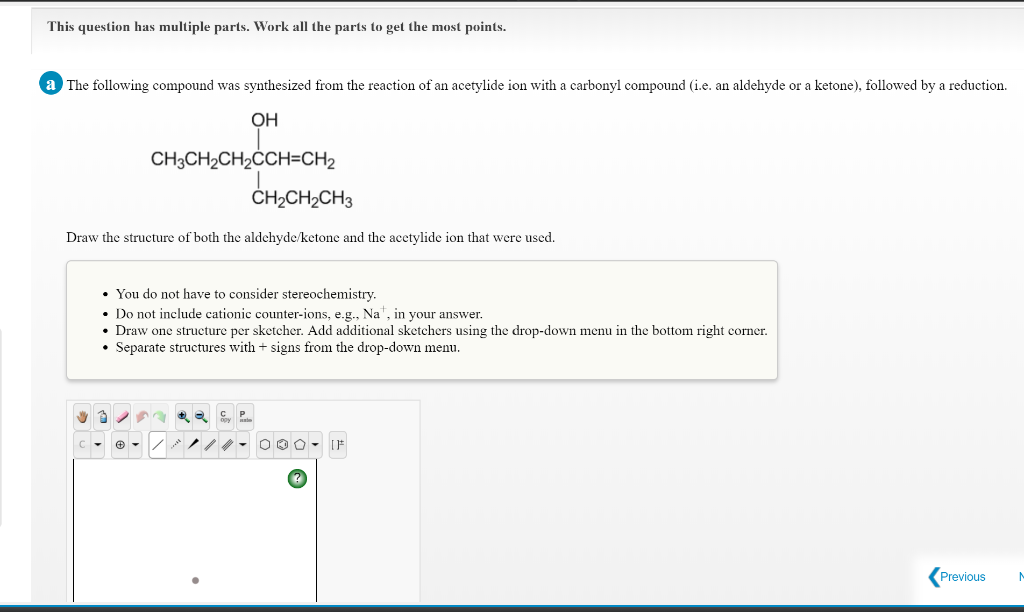a The following compound was synthesized from the reaction of an acetylide ion with a carbonyl compound (i.e. an aldehyde or a ketone), followed by a reduction. OH CH3CH2CH2ČCH=CH2 CH2CH2CH3 Draw the structure of both the aldehyde/ketone and the acetylide ion that were used. • You do not have to consider stereochemistry. • Do not include cationic counter-ions, e.g., Na', in your answer. • Draw one structure per sketcher. Add additional sketchers using the drop-down menu in the bottom right corner. • Separate structures with + signs from the drop-down menu. O00 - IF Previous
a The following compound was synthesized from the reaction of an acetylide ion with a carbonyl compound (i.e. an aldehyde or a ketone), followed by a reduction. OH CH3CH2CH2ČCH=CH2 CH2CH2CH3 Draw the structure of both the aldehyde/ketone and the acetylide ion that were used. • You do not have to consider stereochemistry. • Do not include cationic counter-ions, e.g., Na', in your answer. • Draw one structure per sketcher. Add additional sketchers using the drop-down menu in the bottom right corner. • Separate structures with + signs from the drop-down menu. O00 - IF Previous
Organic Chemistry: A Guided Inquiry
2nd Edition
ISBN:9780618974122
Author:Andrei Straumanis
Publisher:Andrei Straumanis
Chapter26: Aldol And Claisen Reactions
Section: Chapter Questions
Problem 39CTQ
Related questions
Question
100%

Transcribed Image Text:This question has multiple parts. Work all the parts to get the most points.
a The following compound was synthesized from the reaction of an acetylide ion with a carbonyl compound (i.e. an aldehyde or a ketone), followed by a reduction.
OH
CH3CH2CH2CCH=CH2
ČH»CH2CH3
Draw the structure of both the aldehyde/ketone and the acetylide ion that were used.
• You do not have to consider stereochemistry.
• Do not include cationic counter-ions, e.g., Na", in your answer.
Draw one structure per sketcher. Add additional sketchers using the drop-down menu in the bottom right corner.
• Separate structures with + signs from the drop-down menu.
Previous
Expert Solution
This question has been solved!
Explore an expertly crafted, step-by-step solution for a thorough understanding of key concepts.
This is a popular solution!
Trending now
This is a popular solution!
Step by step
Solved in 3 steps with 2 images

Knowledge Booster
Learn more about
Need a deep-dive on the concept behind this application? Look no further. Learn more about this topic, chemistry and related others by exploring similar questions and additional content below.Recommended textbooks for you

Organic Chemistry: A Guided Inquiry
Chemistry
ISBN:
9780618974122
Author:
Andrei Straumanis
Publisher:
Cengage Learning

Organic Chemistry: A Guided Inquiry
Chemistry
ISBN:
9780618974122
Author:
Andrei Straumanis
Publisher:
Cengage Learning